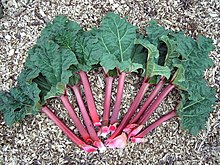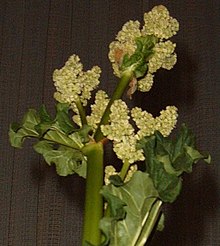Rhubarb
From Wikipedia, the free encyclopedia
For other uses, see Rhubarb (disambiguation).

| Rhubarb | |
|---|---|
| Scientific classification | |
| Kingdom: | Plantae |
| (unranked): | Angiosperms |
| (unranked): | Eudicots |
| (unranked): | Core eudicots |
| Order: | Caryophyllales |
| Family: | Polygonaceae |
| Genus: | Rheum |
| Species: | R. rhabarbarum |
| Binomial name | |
| Rheum rhabarbarum L. | |
Rheum rhabarbarum, Rhubarb is a species of plant in the family Polygonaceae. They are herbaceous perennials growing from short, thick rhizomes. They have large leaves that are somewhat triangular, with long fleshy petioles. They have small flowers grouped in large compound leafy greenish-white to rose-red inflorescences.
In culinary use, fresh raw petioles (leaf stalks) are crisp (similar to celery) with a strong, tart taste. Most commonly, the plant's leaf stalks are cooked with sugar and used in pies and other desserts. A number of varieties have been domesticated for human consumption, most of which are recognised asRheum x hybridum by the Royal Horticultural Society.
Rhubarb is usually considered to be a vegetable; however, in the United States, a New York court decided in 1947 that since it was used in the United States as a fruit, it was to be counted as a fruit for the purposes of regulations and duties. A side effect was a reduction on imported rhubarb tariffs, as tariffs were higher for vegetables than fruits.[1]
Rhubarb also contains glycosides especially rhein, glucorhein and emodin which impart cathartic and laxative activities to it. It is hence useful as a cathartic in case of constipation.[2]
Cultivation
Rhubarb is now grown in many areas and, thanks to greenhouse production, is available throughout much of the year. Rhubarb grown in hothouses (heated greenhouses) is called hothouse rhubarb, and is typically made available at consumer markets in early spring, before outdoor cultivated rhubarb is available. Hothouse rhubarb is usually brighter red, more tender and sweeter-tasting than outdoor rhubarb.[3] In temperate climates, rhubarb is one of the first food plants to be ready for harvest, usually in mid- to late spring (April/May in the Northern Hemisphere, October/November in theSouthern Hemisphere, and the season for field-grown plants lasts until September. In the northwestern US states of Oregon and Washington, typically two harvests are from late April to May and from late June into July. Rhubarb is ready to be consumed as soon as it is harvested, and freshly cut stalks will be firm and glossy.
In the United Kingdom, the first rhubarb of the year is harvested by candlelight in forcing sheds - where all other light is excluded - a practice that produces a sweeter, more tender stalk.;[4] these sheds are dotted around the noted "Rhubarb Triangle" of Wakefield, Leeds, and Morley,[5]
Rhubarb will grow year-round in warm climates, but in temperate climates, the aboveground portion of the plant completely withers away at the onset of freezing temperature; the plant grows from the root at the return of warm weather. Rhubarb growth can be 'forced' or encouraged to grow early by raising the local temperature, usually by placing an upturned bucket over the new shoots. Because rhubarb is a seasonal plant, obtaining fresh rhubarb out of season is difficult in colder climates, such as in the UK, Ireland, Russia, etc. Rhubarb will thrive when planted in areas of direct sunlight.
Rhubarb can successfully be planted in containers, so long as they are large enough to accommodate a season's growth.
The colour of rhubarb stalks can vary from the commonly associated crimson red, through speckled light pink, to simply light green. Rhubarb stalks are poetically described as "crimson stalks". The colour results from the presence of anthocyanins, and varies according to both rhubarb variety and production technique. The colour is not related to its suitability for cooking:[6] The green-stalked rhubarb is more robust and has a higher yield, but the red-coloured stalks are much more popular with consumers.[citation needed]
[edit]Historical cultivation
Rhubarb has been used for medical purposes by the Chinese for thousands of years,[2] and appears in The Divine Farmer's Herb-Root Classic, which legend attributes to the mythical Shen Nung, the Yan Emperor, but is thought to have been compiled about 2700 years ago.[7] Though Dioscurides' description of ρηον or ρά, a root brought to Greece from beyond the Bosphorus may have included rhubarb, the commerce did not become securely established until Islamic times, when it was imported along the Silk Road, reaching Europe in the 14th century through the ports of Aleppo and Smyrna, and becoming known as "Turkish rhubarb". Later, when the usual route lay through Russia, "Russian rhubarb" became the familiar term.[8]
For centuries, the plant has grown wild along the banks of the River Volga, for which the ancient Scythian hydronym was Rhā.[9] The expense of transportation across Asia caused rhubarb to be highly expensive in medieval Europe, where it was several times the price of other valuable herbs and spices such as cinnamon, opium and saffron. The merchant explorer Marco Polo was therefore much interested to find the plant being grown and harvested in the mountains of Tangut province.[7] A measure of the value set upon rhubarb can be gotten from Ruy Gonzáles de Clavijo's report of his embassy in 1403-05 to Timur in Samarkand: "The best of all merchandise coming to Samarkand was from China: especially silks, satins, musk, rubies, diamonds, pearls, and rhubarb...".[10]
The term "rhubarb" is a combination of the Ancient Greek rha and barbarum; rha refers both to the plant and to the River Volga.[11] Rhubarb first came to the United States in the 1820s, entering the country in Maine and Massachusetts and moving westwards with the European American settlers.[12]
[edit]Uses
Rhubarb is grown primarily for its fleshy stalks, technically known as petioles. The use of rhubarb stems as food is a relatively recent innovation, first recorded in 17th century England, after affordable sugar became available to common people, and reaching a peak between the 20th century's two world wars.
Commonly, it is stewed with sugar or used in pies and desserts, but it can also be put into savory dishes or pickled. Rhubarb can be dehydrated and infused with fruit juice. In most cases, it is infused with strawberry juice to mimic the popular strawberry rhubarb pie.
Rhubarb root produces a rich brown dye similar to walnut husks. It is used in northern regions where walnut trees do not survive.
[edit]Cooking
For cooking, the stalks are often cut into 1 inch (2.5 cm) pieces and stewed (boil in water); it is necessary only to barely cover the stalks with water because rhubarb stalks contain a great deal of water on their own; 1/2 to 3/4 cup of sugar is added for each pound of rhubarb;[3] Spices such ascinnamon and/or nutmeg can be added to taste. Sometimes a tablespoon of lime juice or lemon juice is added. The sliced stalks are boiled until soft. An alternative method is to simmer slowly without adding water, letting the rhubarb cook in its own juice.
At this stage, either alone or cooked with strawberries or apples as a sweetener, or with stem or root ginger, rhubarb can be used to make jam. Other fruits, with the addition of pectin (or using sugar with pectin already added), can be added to rhubarb to make a variety of jams.
A sauce (to which dried fruit could be added near the end) can be made by cooking further, until the sauce is mostly smooth and the remaining discrete stalks can easily be pierced with a fork, yielding a smooth tart-sweet sauce with a flavor similar to sweet and sour sauce. This sauce, rhubarb sauce, is analogous toapplesauce. Like applesauce, this sauce is usually stored in the refrigerator and eaten cold. The sauce, aftercornstarch mixed with water has been added to thicken it, may be used as filling for rhubarb pie, tarts, andcrumbles. Sometimes stewed strawberries are mixed with the rhubarb to make strawberry-rhubarb pie. This common use has led to the slang term for rhubarb, "pie plant", by which name it was more commonly known in the United States in the late 19th century. In her novella The First Four Years,American author Laura Ingalls Wilder refers to rhubarb as "pie plant". It can also be used to make a fruit wine.
In former days, a common and affordable sweet for children in parts of the United Kingdom and Sweden was a tender stick of rhubarb, dipped in sugar. It is still eaten this way in western Finland and Norway, Iceland and some other parts of the world, including rural eastern Ontario. In Chile, Chilean rhubarb is sold on the street with salt or dried chile pepper, not sugar.
[edit]Medicine
Rhubarb can be used as a strong laxative.[2] Its roots have been used as a laxative for at least 5,000 years.[13]
The roots and stems are rich in anthraquinones, such as emodin and rhein.[2] These substances are cathartic and laxative, which explains the sporadic use of rhubarb as a dieting aid. These molecules also contain sugars attached to them and are hence glycosides. Glycosides can retain water more thus adding to the cathartic action.[2]
Rhubarb roots are used in traditional Chinese medicine; rhubarb also appears in medieval Arabic and European prescriptions.[14][15]
The rhizomes ('roots') contain stilbenoid compounds (including rhaponticin), which seem to lower blood glucose levels in diabetic mice.[16]
[edit]Toxicity
Rhubarb leaves contain poisonous substances, including oxalic acid which is a nephrotoxic and corrosive acid that is present in many plants. The LD50(median lethal dose) for pure oxalic acid in rats is about 375 mg/kg body weight,[17] or about 25 grams for a 65 kg (~140 lb) human. (Other sources give a much higher oral LDLo (lowest published lethal dose) of 600 mg/kg.[18]) While the oxalic acid content of rhubarb leaves can vary, a typical value is about 0.5%,[19] so a rather unlikely 5 kg of the extremely sour leaves would have to be consumed to reach an LD50 of oxalic acid. Cooking the leaves with soda can make them more poisonous by producing soluble oxalates.[20] However, the leaves are believed to also contain an additional, unidentified toxin,[21] which might be an anthraquinone glycoside (also known as senna glycosides).[22]
In the petioles, the amount of oxalic acid is much lower, only about 2-2.5% of the total acidity, which is dominated by malic acid.[23] This means the raw stalks may not be hazardous, although the tart taste of raw stalks is so strong as to be unpalatable to many.
[edit]Pests
The rhubarb curculio, Lixus concavus, is a weevil. Rhubarb is a host, damage being visible mainly on the leaves and stalks, with gummosis and oval or circular feeding and/or egg-laying sites.[24]
Hungry wildlife may dig up and eat rhubarb roots in the spring, as stored starches are turned to sugars for new foliage growth.
| Nutritional value per 100 g (3.5 oz) | |
|---|---|
| Energy | 88 kJ (21 kcal) |
| Carbohydrates | 4.54 g |
| - Sugars | 1.1 g |
| - Dietary fibre | 1.8 g |
| Fat | 0.2 g |
| Protein | 0.9 g |
| Water | 93.61 g |
| Folate (vit. B9) | 7 μg (2%) |
| Vitamin C | 8 mg (10%) |
| Vitamin E | 0.27 mg (2%) |
| Vitamin K | 29.3 μg (28%) |
| Calcium | 86 mg (9%) |
| Iron | 0.22 mg (2%) |
| Potassium | 288 mg (6%) |
| Sodium | 4 mg (0%) |
| Zinc | 0.1 mg (1%) |
| Percentages are relative to US recommendations for adults. Source: USDA Nutrient Database | |




No comments:
Post a Comment